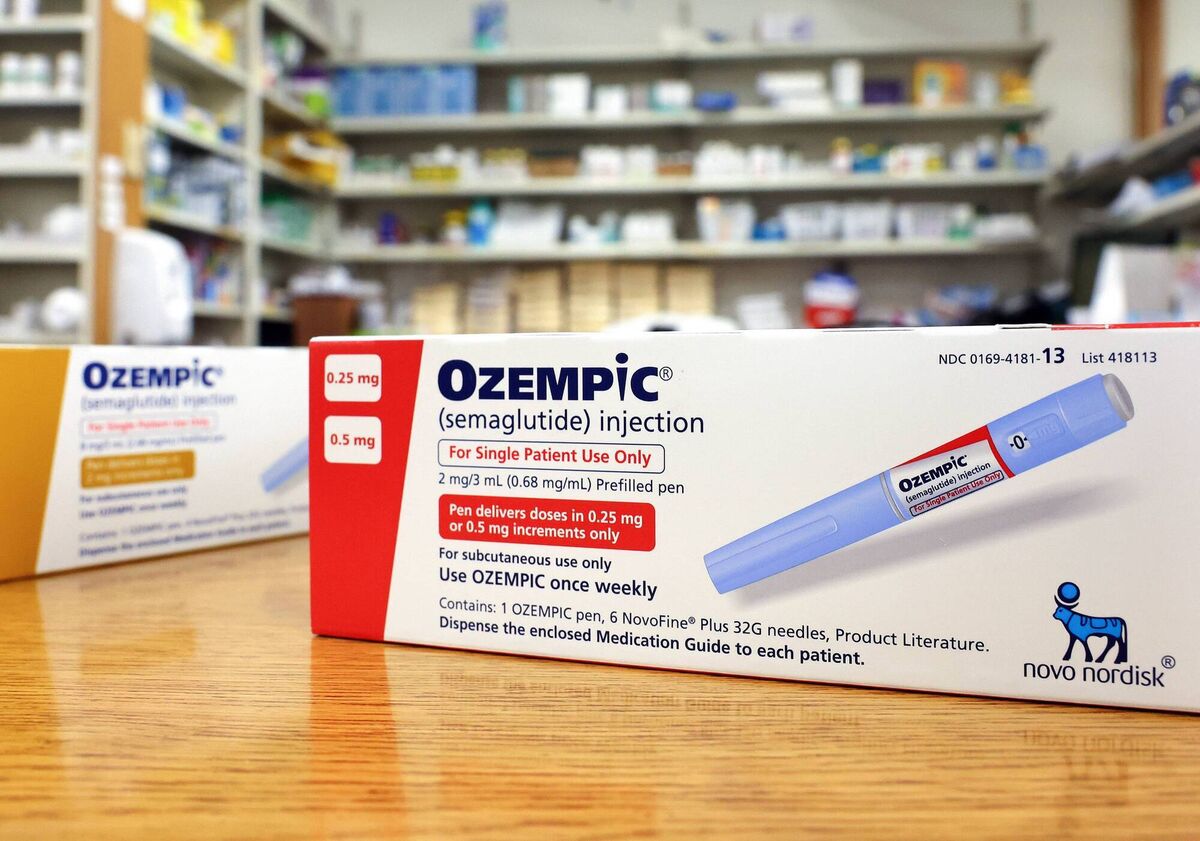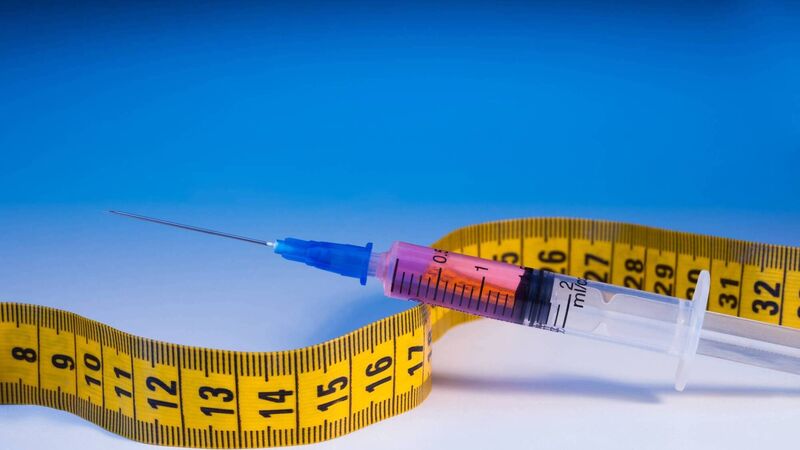YOU’VE seen them on TV ads and TikTok, or heard them joked about at the Oscars — Ozempic, Wegovy, and Mounjaro.
Thanks to celebrity endorsements from the likes of Kim Kardashian and Elon Musk these so-called “wonder” drugs have been hijacked by a generation of users who are flooding social media with posts and videos boasting their properties as a “miracle” weight loss hack.
As a result, demand has soared leading to a global shortage, even though they’re prohibitively expensive, or as is the case in Ireland, they can only be prescribed for the treatment of diabetes and not for weight loss. Or at least not yet.
In the US alone, about 130m adults are eligible for these so-called GLP-1s because of their weight and other health conditions.
If just a third of Americans with severe obesity took them, US sales of weight loss drugs would swell more than 30 times, into an $80bn industry, according to data analytics company, Airfinity Ltd.
Analysts at Jefferies Financial Group predict that GLP-1s for diabetes and obesity could become the biggest blockbusters of all time, bringing in as much as $150bn (€137bn) a year globally.

The impact for health systems and insurance companies across the world could also be huge with the drugs costing in the region of $10,000 per patient in the US a year, potentially for the rest of someone’s life. (The drugs essentially work as appetite suppressants, and if people stop taking them, they may gain much of the weight back.)
The growing demand for that “quick-fix” weight loss is already evident here with some diabetes patients forced to switch from Ozempic because of shortages.
Ozempic has been approved by the HSE only to treat type-2 diabetes. The injectable drug regulates blood sugar levels and insulin. More than 260,000 people in Ireland have type-2 diabetes, according to Diabetes Ireland.
Manufacturer Novo Nordisk has warned the drug is only for adults with type-2 diabetes, and “is not a weight-loss drug” — but that hasn’t dampened demand, forcing some countries to take more dramatic action.
Australian authorities have called on health professionals to avoid initiating new prescriptions of Ozempic and, when treating patients with obesity, to consider alternatives to semaglutide [generic name of Ozempic] “until supply stabilises”.
France’s national drug safety agency issued similar instructions in September when it urged doctors to only initiate new GLP-1 drug prescriptions for patients with type-2 diabetes with a history of stroke or heart disease.
Last month, the regulator said recent estimates suggested that over the course of a year, some 2,185 patients in France were given Ozempic even though they were not diabetic. That means around 1% of Ozempic prescriptions covered by state health insurance were “misused”, it said.
The agency stressed that these off-label prescriptions were squeezing out diabetic patients who really needed the drug, and it warned of “potentially serious” side-effects such as gastrointestinal disorders, pancreatitis, and low blood sugar.
Authorities in the UK have also issued warnings to influencers promoting these drugs online.
Supply lines under pressure
While the use of these drugs here is far more restricted, supply lines are under increasing pressure.
Pharmacists have warned it can take months for stocks to be replenished — with Health Minister Stepehen Donnelly telling the Dáil recently that it will be well into next year before the supplies of Ozempic settle down.
That’s cold comfort to patients here who have been forced to switch drugs or go weeks without.
Corkman, Pat Murphy, was told four weeks ago he would not receive a refill prescription for Ozempic because it wasn’t in stock in his local pharmacy.
“I got a call on Tuesday saying they had my refill, and when I went in, I was speaking to my chemist who said they were finding it very hard to get the supply in.
“But it’s not just the only chemist in Cork that is seeing this problem, because I’ve tried others, to see if I could get the prescription. And I couldn’t get it.
Mr Murphy was diagnosed with type-2 diabetes 15 years ago but has only been taking the drug for a year.
The medication helps regulate his blood sugar levels. However, the longest he can go without Ozempic is four weeks before switching to another drug.
“If it’s not there next month it will mean I could be without it for a month again,” Mr Murphy said.
“Which means then I probably have to go and change from the Ozempic to something else which means I’d be starting again from scratch.
“And I will be sick again for a couple of months because my body is getting used to this new drug and I don’t really want to do that. But if have to, I’ll have to.”
So how do these drugs work?
The drugs that have drawn the most attention are a class of medications that activate a hormone known as GLP-1. They include Ozempic and Wegovy, which are brand names of the same medication, semaglutide.
Tirzepatide targets GLP-1, but also affects a second hormone, called GIP, which developers say contributes to its increased effectiveness. Mounjaro was approved to treat diabetes in May 2022. Saxenda was the first new-generation drug for the treatment of obesity.
The drugs are delivered through once-weekly injections. Users are advised to follow a healthful, reduced-calorie diet and to exercise regularly while using the drugs.
The HSE started reimbursing Saxenda for the treatment of obesity last January.
Ozempic was approved by the HSE in 2018 but only for treating type-2 diabetes.
The drugs work by mimicking the actions of hormones, found primarily in the gut, that kick in after people eat. The hormones help regulate blood sugar by triggering the pancreas to release insulin, another hormone, and slowing the release of sugar from the liver.
People who are overweight or have obesity can become insulin-resistant, which means the body doesn’t respond to insulin properly.
The obesity drugs lower blood sugar and slow down digestion, so people feel full longer. They also affect signals in the brain linked to feelings of fullness and satisfaction, tamping down appetite, food-related thoughts, and cravings.
Because people feel full longer, they eat less and lose weight.
In a trial, adults who took Wegovy saw a weight loss of nearly 35lb, or about 15% of their body weight. Adolescents lost about 16% of their body weight.
The latest study of tirzepatide studied the drug in more than 900 patients with diabetes who were overweight or had obesity over nearly 17 months. It showed weight loss of up to 16% of body weight, more than 34lb, when using the highest dose of the drug. Patients who received placebo, or dummy injections, lost about 3% of their body weight, or seven pounds.
An earlier trial of tirzepatide showed weight loss of between about 15% and about 22% of body weight, or about 35lb to about 52lb, depending on the dose.
The drugs appear effective for chronic weight management over many months. In addition to weight loss, they also reduce health problems associated with obesity, such as high blood sugar and markers of heart and metabolic disease.
However, it appears that if people stop taking the drugs, they regain the weight they lost — and the health problems that came with it.
In a typical weight-loss programme where participants rely only on diet and exercise, research shows only about a third of people will lose 5% or more of their body weight. Many people find it difficult to lose weight because of the body’s biological reactions to eating less, he said. There are several hormones that respond to reduced calorie intake by ramping up hunger to maintain body mass.
The most common side effects are short-lived gastrointestinal issues such as nausea, vomiting, constipation, diarrhea, and stomach pain. Other possible effects include serious issues such as inflammation of the pancreas, kidney, gallbladder, and eye problems.
People with a history of certain thyroid cancers or a rare, genetic endocrine disorder should avoid the drugs, because it is not clear if tirzepatide causes thyroid problems, including cancer.
According to Professor Carel le Roux, an Obesity Specialist at St Vincent’s University Hospital, who spoke to the Irish Examiner recently, the use of Ozempic or other drugs using semaglutide for the treatment of obesity could be “revolutionary”, but you definitely should not take this drug for weight loss reasons.
“It’s very, very important that we focus this treatment for the disease of obesity and not for weight loss,” he said.
“There is the disease of obesity, and then there’s what we refer to as the cultural desire for thinness.
“If you treat people [with Ozempic] with the disease of obesity, you can control the disease, but it means they have to take this treatment for the rest of their lives.
“For people with the cultural desire for thinness, if they take this treatment, what will happen is they will lose some weight initially but if they stop the treatment, they will regain all the weight and they’ll actually be heavier after than they were before. So it’s really, really bad idea to [use this drug] for weight loss.”
To define obesity, Prof le Roux points to the World Health Organization’s definition: “Abnormal or excessive fat accumulation that presents a risk to health.”
“Your BMI doesn’t really matter, what matters is whether or not the excess adipose tissues or too much fat cells are causing you to be less healthy right now.
“For example, if you’ve got excess fat that causes you to have diabetes, then you have the disease of obesity.”
We don’t treat people for weight loss, we treat people for health gain.”
Prof le Roux says he would urge the Irish public not to take Ozempic unless they have the disease of obesity, and unless they are prepared to take it for the rest of their lives.
“Interestingly, even people that really, really really want to lose weight. If you say to them, ‘do you have the disease of obesity and are you prepared to take this for the rest of your life? Nine out of 10 people will say no’.”
Additional reporting Bloomberg
CONNECT WITH US TODAY
Be the first to know the latest news and updates











